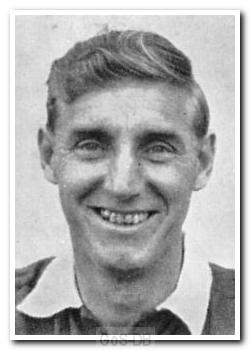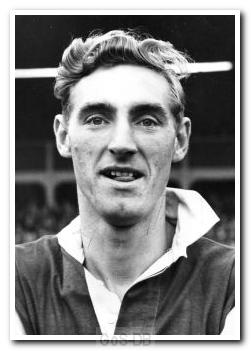
Can you help? This page is the result of the best endeavours of all concerned. If you spot a mistake or know of facts to add, or have a better photo, please get in touch using 'Contact Us' (top, right).
Back to GoS-DB Hub Find Another Player
GEORGE ROBERTSON
Born: 20 April 1930
Came from: Gairdoch Juniors Went to: Falmouth Town
First game: 17 March 1951 Last game: 21 December 1963
Appearances: 382 (382/0) Goals: 2
Born in Bainsford, near Falkirk, Robertson was a right-back who broke into the team as a centre-half following the retirement of "Jumbo" Jack Chisholm - a daunting player to replace! Robertson did have family pedigree though as his father, William, had been a professional with Third Lanark, Ayr United, Stoke City, Manchester United and Reading.
He had arrived at Home Park from Gairdoch Juniors, a club based in the village of Carronshore in Stirlingshire. During his National Service his club had written to Jimmy Rae from Scotland recommending him for a trial. That came when he was based at Salisbury with the RAF, playing in a Devon Wednesday League game, whilst still a teenager, against City Police and doing enough to progress to Argyle's reserves.
After the war, Robertson had initially returned to Scotland. Having heard no more from Argyle he was poised to sign for Stenhousemuir. On hearing of this Argyle reminded him that he had signed amateur terms with the club and that they had first refusal on his services. Thus in January 1950, Robertson duly signed professional terms costing just a £10 signing-on fee. This was probably a thrilling about-turn for Robertson in more ways than one, as, shortly before, he had played for Argyle reserves away at Luton Town on the last day of the 1948-49 season and the team had lost 9-0, convincing him his chance in green had gone.
He played just twice in the first team during his first three years at the club after making his debut in the 1951-52 season. He built up a reputation as a tough-tackling defender as he became a regular member of the team over the following ten years, eventually reverting to his favoured full-back position. With the retirement of Chisholm, Robertson filled in at the classical No.5 position and what he lacked in relation to "Jumbo's" build and physicality he made up for in speed and mobility. The emergence of Peter Langman from the reserves, then enabled Robertson to return to his more favoured no.2 position, becoming a more logical successor to Paddy Ratcliffe.
His longevity with Argyle meant he also played on both of Argyle's international tours, to the USA in 1954 and to Eastern Europe in 1963, the latter providing a fitting finale as he approached his mid-30s and had only made nine appearances that season.
Declining a new contract on the basis of limited first-team opportunities, he was appointed player-manager of Falmouth Town and accepted a job offer to become groundsman at Plymouth College. He had made just under 400 appearances for Argyle, scoring twice, putting him inside the top 15 appearance-makers for the club. One of his two goals was notable and it came late on in his Argyle career on the last day of the 1961-62 season against Liverpool, no less. The goal was notable for two reasons: Liverpool fielded George's cousin Tommy Leishman and George scored his goal against future Argyle goalkeeper Jim Furnell.
He won medals during his time with the club too as he had been part of Argyle's 1951-52 Division Three (South) championship-winning team as well as the 1958-59 Division Three championship-winning team. Though sandwiched in between the two was the relegation from Division Two in 1955-56.
He did return to Home Park in May 1964 for a testimonial game to honour his 13 seasons at the club, against an "All Stars" side, the guests running out 2-4 winners.
Continuing playing in Cornwall, he played 166 times for Falmouth over the coming seasons, scoring 16 times and won several Western League titles and Cornish Senior Cups. He also led the team to the FA Cup 1st Round (proper) in 1967-68, where they lost 5-2 away at Peterborough United.
With Billy Bingham being appointed Argyle manager in 1968, he was asked to return to the club to run the third team in the Plymouth & District (P&D) League team. His involvement with the club continued into the 1970s and under Tony Waiters, when he ran the club's new youth hostel (Elm Cottage), with his wife, looking after the club's fledgling younger players. The youth scheme was phased out after Tony Waiters' departure, but Robertson returned again, this time as Home Park's groundsman in the 1980s.
He was rewarded for his continuing long service to the club, in May 1986 when former Argyle player and manager, Bobby Saxton, who would have no doubt worked with him during his time at Home Park, bought his Blackburn Rovers team to Home Park for a rare second Testimonial game. Argyle ran out 2-0 winners, with goals from Steve Cooper and Kevin Hodges in front of 1,972 who braved the pre-match downpour.
In later life, Robertson became a milkman and also had a spell running the Golden Hind pub in Mannamead, Plymouth. He remained living locally and he died in Plymouth in March 2003, at the age of 72.
YOUR CONTRIBUTION
If you can add to this profile, perhaps with special memories, a favourite story or the results of your original research, please contribute here.
From John Beresford in Cambridge on 20/04/2016 ...
I was in the school 1st XV when George was groundsman at Plymouth College, and he turned out to be a bit of a guardian angel on my last day. The night before, the team had held its annual get-together at the home of our coach, Ted Mercer (Ted was also well-known at the time for his post-match summaries of Argyle’s home games on Saturday’s ‘Sports Report’). Ted had a neat line in home-made wine, and I took on board a little too much. Consequently I had to spend the evening at his house, and in the morning George Robertson was kind enough to give me a lift to my house in far-off Plympton, wait for me to change and drive me back to school again, where I said goodbye to the school (I was Head Boy) with the mother of all headaches. George was a true gentleman, as well as a guardian angel.
APPEARANCE DETAILS [reselect competitions]
The details below reflect appearances in all first-team competitions.
I'm very grateful to many who have helped write GoS-DB's player pen-pictures, and to Dave Rowntree, the PAFC Media Team and Colin Parsons for their help with photos. Thanks also to staff at the National Football Museum, the Scottish Football Museum and ScotlandsPeople for their valuable assistance.
The following publications have been particularly valuable in the research of pen-pictures: Plymouth Argyle, A Complete Record 1903-1989 (Brian Knight, ISBN 0-907969-40-2); Plymouth Argyle, 101 Golden Greats (Andy Riddle, ISBN 1-874287-47-3); Football League Players' Records 1888-1939 (Michael Joyce, ISBN 1-899468-67-6); Football League Players' Records 1946-1988 (Barry Hugman, ISBN 1-85443-020-3) and Plymouth Argyle Football Club Handbooks.
Greens on Screen is run as a service to fellow supporters, in all good faith, without commercial or private gain. We have no wish to abuse copyright regulations and apologise unreservedly if this occurs. If you own any of the material on this site, and object to its inclusion, please get in touch using the 'Contact Us' button at the top of the page.

